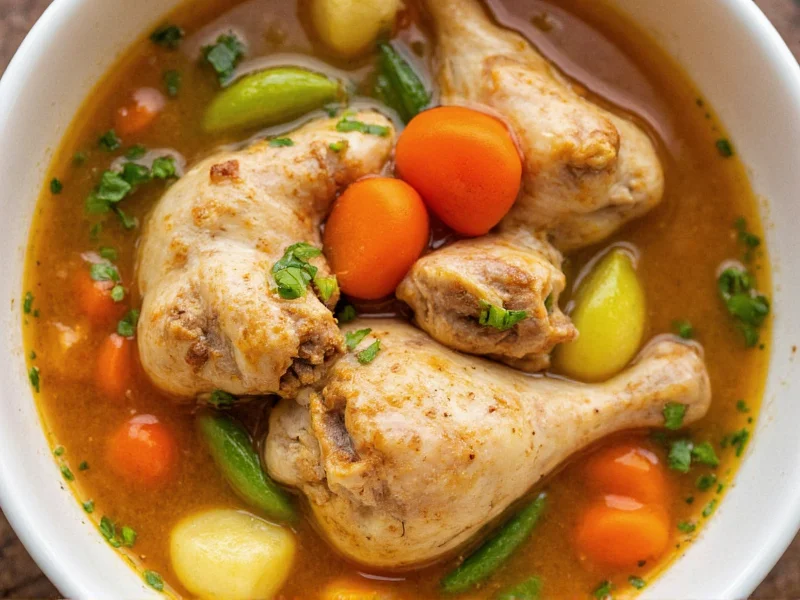Why Rotisserie Chicken Elevates Soup Quality
Rotisserie chicken offers three distinct advantages for soup preparation that home cooks consistently appreciate. The slow-roasting process develops complex Maillard reaction flavors in the skin and meat that can't be replicated with raw chicken. Food science shows these caramelized compounds dissolve into the broth, creating richer depth than standard stock. Additionally, the pre-cooked meat maintains perfect tenderness when added late in the cooking process - raw chicken often becomes tough when simmered for soup's required duration.
Professional chefs confirm that rotisserie chicken bones produce superior broth compared to raw bones. The bones have already released initial collagen during roasting, allowing them to break down more completely during simmering. This creates a silkier mouthfeel and more pronounced body in your finished soup. When selecting rotisserie chicken, choose birds with visible herbs under the skin for additional flavor dimensions.
Essential Components for Perfect Rotisserie Chicken Soup
The foundation of exceptional rotisserie chicken soup combines three elements: the chicken itself, aromatic vegetables, and proper seasoning technique. For a standard 6-8 serving batch, you'll need one 2-3 pound rotisserie chicken (meat and bones), 4 cups of liquid (water or light broth), and 2 cups of chopped vegetables. The vegetable ratio follows the classic mirepoix formula: 50% onions, 25% carrots, 25% celery.
| Vegetable Component | Preparation Method | Timing |
|---|---|---|
| Onions, carrots, celery | Medium dice (1/4 inch) | Saute 8-10 minutes |
| Garlic | Minced | Add after vegetables soften |
| Herbs (thyme, parsley) | Whole sprigs | Add with liquid |
| Shredded chicken | Hand-shredded | Final 10 minutes |
Step-by-Step Preparation Guide
Begin by separating the rotisserie chicken meat from bones and skin. Reserve 3-4 cups of meat for later addition, discarding skin and any excess fat. Place bones in a 4-6 quart pot with 4 cups water, 1 bay leaf, and 1 teaspoon black peppercorns. Simmer uncovered for 45 minutes while skimming foam.
Meanwhile, sauté 1 diced onion, 1/2 cup diced carrots, and 1/2 cup diced celery in 2 tablespoons olive oil over medium heat until translucent (8-10 minutes). Add 2 minced garlic cloves and cook 1 minute until fragrant. Pour vegetables into the simmering broth along with any accumulated chicken juices.
Continue simmering 15 minutes to develop flavors, then remove bay leaf and strain broth through a fine-mesh sieve. Return clear broth to pot and bring to gentle simmer. Stir in reserved shredded chicken and 1/2 cup chopped fresh parsley. Cook 5-7 minutes until heated through. Season with salt to taste - remember rotisserie chicken often contains salt, so taste before adding.
Avoiding Common Preparation Mistakes
Many home cooks make critical errors when using rotisserie chicken for soup. The most frequent mistake is adding the meat too early, causing it to become dry and stringy during prolonged simmering. Always add pre-cooked chicken during the final 10 minutes. Another common issue involves oversalting - rotisserie chickens typically contain 300-500mg sodium per serving, so wait until the end to adjust seasoning.
Don't discard the fat cap from the rotisserie chicken bones. This small amount of fat carries tremendous flavor and should be included when making your broth. However, skim excess fat from the finished broth using a fat separator or by chilling briefly and removing the solidified layer. For creamier soups, add dairy after removing from heat to prevent curdling.
Creative Variations for Different Preferences
Transform your basic rotisserie chicken soup into distinct culinary experiences with simple modifications. For a creamy version, whisk 1/2 cup heavy cream into the finished soup off-heat. Add 2 tablespoons cornstarch slurry if you need thickness without dairy. Mediterranean style emerges by adding 1/2 cup chopped sun-dried tomatoes, 1/4 cup olives, and 2 tablespoons lemon juice during the final simmer.
Dietary adaptations work beautifully with this base recipe. Make it gluten-free by ensuring all broth components are certified GF - most store-bought rotisserie chickens contain gluten-free seasonings. For keto versions, replace starchy vegetables with radishes, celery root, and extra celery. Asian-inspired variations shine with 2 tablespoons soy sauce, 1 tablespoon grated ginger, and 1 teaspoon sesame oil added at the end, plus bok choy instead of traditional vegetables.
Storage and Reheating Best Practices
Proper storage maintains your rotisserie chicken soup's quality for future meals. Cool soup completely within 2 hours of cooking, then transfer to airtight containers leaving 1-inch headspace for expansion. Refrigerated soup stays fresh for 3-4 days. For longer storage, freeze in portion-sized containers for up to 3 months.
Reheat gently to preserve texture - rapid boiling makes chicken tough and vegetables mushy. Thaw frozen soup overnight in the refrigerator before reheating. When warming, add a splash of water or broth to compensate for liquid absorption during storage. Never reheat soup more than once, and always bring to 165°F internal temperature for food safety. Cream-based versions require extra care - reheat over low heat while stirring constantly to prevent separation.











 浙公网安备
33010002000092号
浙公网安备
33010002000092号 浙B2-20120091-4
浙B2-20120091-4